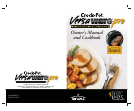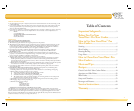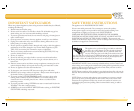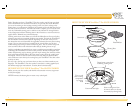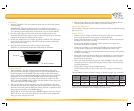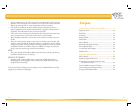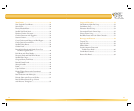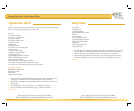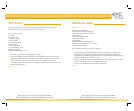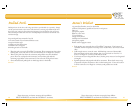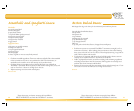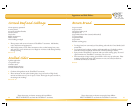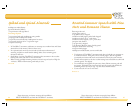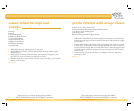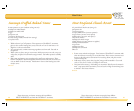
HOW TO CLEAN YOUR SLOW COOKER
• ALWAYS turn off your slow cooker, unplug it from the electrical outlet, and
allow it to cool before cleaning.
• e lid and VersaWare™ Pro slow cooker stoneware can be washed in the
dishwasher or with hot, soapy water. Do not use abrasive cleaning compounds or
scouring pads. A cloth, sponge, or rubber spatula will usually remove any residue.
To remove water spots and other stains, use a non-abrasive cleaner or vinegar.
• e lid will not withstand sudden temperature changes. Do not wash the lid with
cold water when it is hot.
• e outside of the heating base may be cleaned with a soft cloth and warm, soapy
water. Wipe dry. Do not use abrasive cleaners.
CAUTION: Never immerse the heating base in water or other liquid.
HINTS AND TIPS
PASTA AND RICE
• If you are converting a recipe that calls for uncooked noodles, macaroni, or pasta,
cook them on the stovetop just until slightly tender before adding to slow cooker.
• If you are converting a recipe that calls for cooked rice, stir in raw rice with
other ingredients; add
1
/
4
cup extra liquid per
1
/
4
cup of raw rice. Use long grain
converted rice for best results in all-day cooking.
BEANS
• Beans must be softened completely before combining with sugar and/or
acidic foods. Sugar and acid have a hardening eff ect on beans and will prevent
softening.
• Dried beans, especially red kidney beans, should be boiled before adding to a
recipe. Cover the beans with three times their volume of unsalted water and
bring to a boil. Boil 10 minutes, reduce heat, cover and allow to simmer 1
1
/
2
hours
or until beans are tender. Soaking in water, if desired, should be completed before
boiling. Discard water after soaking or boiling.
• Fully cooked canned beans may be used as a substitute for dried beans.
VEGETABLES
• Many vegetables benefi t from slow cook times and low temperatures and are able
to develop their full fl avor. ey tend not to overcook in your slow cooker as they
might in your oven or on your stovetop.
• When cooking recipes with vegetables and meat, place the vegetables in the
stoneware before the meat. Vegetables usually cook slower than meat in the slow
cooker.
• Place vegetables near the sides or bottom of the stoneware to facilitate cooking.
Stir in chopped or sliced vegetables with other ingredients.
• Because eggplant has a very strong fl avor, you should parboil or sauté the
eggplant before adding it to the slow cooker.
LIQUIDS
• It is not necessary to use more than
1
/
2
to 1 cup liquid in most instances since
juices in meats and vegetables are retained more in slow cooking than in
conventional cooking.
• When converting conventional cooking recipes to slow cooking recipes, use
about half of the recommended amount of liquids, except in recipes that contain
uncooked rice or pasta (see previous page).
MILK
• Milk, cream, and sour cream break down during extended cooking. When
possible, add during last fi fteen minutes to half hour of cooking, until just heated
through.
• Condensed soups may be substituted for milk and can cook for extended times.
SOUPS
• Some soup recipes call for 2 to 3 quarts of water. Add other soup ingredients to
the slow cooker fi rst; then add water only to cover. If thinner soup is desired, add
more liquid at serving time.
• If milk-based soup recipes have no other liquid for initial cooking, add 1 or 2
cups water. Since milk, cream or sour cream will break down if heated above
boiling point, carefully stir them in at end of cooking cycle.
MEATS
• For meats, trim fats, wipe or rinse well, and pat dry with paper towels. Browning
meat in a separate skillet or broiler allows fat to be drained off before slow
cooking and also adds greater depth of fl avor to dish.
• Larger roasts, chickens, and hams are the perfect size for your slow cooker. Select
boneless roasts or hams ranging from 2 to 4 pounds for a 4-quart slow cooker,
2.5 to 5 pounds for a 5-quart slow cooker, and 3 to 6 pounds for a 6-quart slow
cooker.
• Bone-in cuts like ribs, loin cuts, or turkey pieces fi t easily and cook well in your
slow cooker. Cook turkey legs, thighs, and breasts, up to 4 pounds for 4-quart
slow cookers, 5 pounds for 5-quart slow cookers, and 6 pounds for 6-quart slow
cookers.
• If you select a smaller roast, alter the amount of vegetables or potatoes so that the
stoneware is
1
/
2
to
3
/
4
full.
8 9



